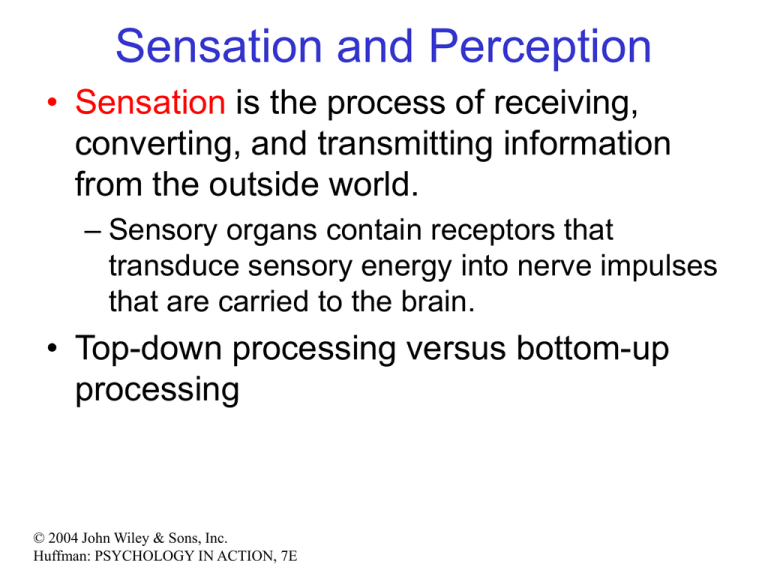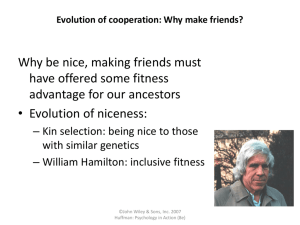
Sensation and Perception
• Sensation is the process of receiving,
converting, and transmitting information
from the outside world.
– Sensory organs contain receptors that
transduce sensory energy into nerve impulses
that are carried to the brain.
• Top-down processing versus bottom-up
processing
© 2004 John Wiley & Sons, Inc.
Huffman: PSYCHOLOGY IN ACTION, 7E
Sensation/Perception
• Transduction: sensory receptors convert
a physical energy into nerve impulses
© 2004 John Wiley & Sons, Inc.
Huffman: PSYCHOLOGY IN ACTION, 7E
Understanding Sensation: Processing
Three Types of Processing:
1.
Transduction: converts sensory stimuli into
neural impulses that are sent on to the brain
2.
Sensory Reduction: filters and analyzes
incoming sensations before sending on to the
brain
3.
Coding: converts particular sensory input into
a specific sensation sent to differing parts of
the brain
© 2004 John Wiley & Sons, Inc.
Huffman: PSYCHOLOGY IN ACTION, 7E
Sensory Thresholds
• Psychophysics: testing limits and changes
• Absolute Threshold: smallest amount of a
stimulus we can detect
• Difference Threshold: minimal difference
needed to detect a a stimulus change; also
called the just noticeable difference (JND)
© 2004 John Wiley & Sons, Inc.
Huffman: PSYCHOLOGY IN ACTION, 7E
Modification of Sensation
• A key function of sensory systems is to
detect change within the environment.
– Movement in the peripheral aspects of the eye
may signal food or danger.
– Constant pressure of an object on the skin may
not be important.
• A stimulus that moves across the skin may be a
snake or a spider.
• The skin adapts to constant pressure.
© 2004 John Wiley & Sons, Inc.
Huffman: PSYCHOLOGY IN ACTION, 7E
Sensory Adaptation
• Sensory adaptation refers to the fact
that repeated or constant stimulation
decreases the number of sensory
messages sent to the brain, which
causes decreased sensation.
© 2004 John Wiley & Sons, Inc.
Huffman: PSYCHOLOGY IN ACTION, 7E
Gate-Control Theory of Pain
• Pain sensations are processed and
altered by mechanisms within the spinal
cord.
– Endorphins relieve pain by inhibiting pain
perception.
© 2004 John Wiley & Sons, Inc.
Huffman: PSYCHOLOGY IN ACTION, 7E
Vision
• External light falls on receptors within the
eye to generate the visual message.
• Light = electromagnetic radiation
– Wavelength of light determines color
© 2004 John Wiley & Sons, Inc.
Huffman: PSYCHOLOGY IN ACTION, 7E
Physical/Perceptual properties of light
© 2004 John Wiley & Sons, Inc.
Huffman: PSYCHOLOGY IN ACTION, 7E
Physical/Perceptual properties of light
• Light waves vary in:
• length (wavelength), which
determines frequency (hue or color).
• height (amplitude), which determines
brightness or intensity.
© 2004 John Wiley & Sons, Inc.
Huffman: PSYCHOLOGY IN ACTION, 7E
Anatomy of the Eye
© 2004 John Wiley & Sons, Inc.
Huffman: PSYCHOLOGY IN ACTION, 7E
Glaucoma: Open and Closed Angle
© 2004 John Wiley & Sons, Inc.
Huffman: PSYCHOLOGY IN ACTION, 7E
Accommodation
• Accommodation refers to automatic
adjustments of the eye, which occurs
when muscles change the shape of the
lens so that it focuses light on the retina
from objects at different distances.
– Nearsightedness
– Farsightedness
© 2004 John Wiley & Sons, Inc.
Huffman: PSYCHOLOGY IN ACTION, 7E
Eye as optical instrument
Light refraction
© 2004 John Wiley & Sons, Inc.
Huffman: PSYCHOLOGY IN ACTION, 7E
Three layers of eye
© 2004 John Wiley & Sons, Inc.
Huffman: PSYCHOLOGY IN ACTION, 7E
Retina: Rods and Cones (Photoreceptors)
© 2004 John Wiley & Sons, Inc.
Huffman: PSYCHOLOGY IN ACTION, 7E
Retinal Photoreceptors
• Light passes through the
retinal layers to reach the
photoreceptors at the inner
retinal surface.
• Photoreceptors and bipolar
cells conduct potentials to
the ganglion cells, which in
turn initiate action potentials
which are transmitted to the
thalamus.
© 2004 John Wiley & Sons, Inc.
Huffman: PSYCHOLOGY IN ACTION, 7E
Photoreceptors
• Photoreceptors are light-sensitive cells
found within the retina.
– Rods are sensitive to light, but not color,
and are active under low-light conditions.
– Cones are sensitive to color, are not active
in low-light conditions, and allow for fine
detail.
– Rods and cones use different
photopigments that react to light so as to
generate nerve potentials.
© 2004 John Wiley & Sons, Inc.
Huffman: PSYCHOLOGY IN ACTION, 7E
Visual System
© 2004 John Wiley & Sons, Inc.
Huffman: PSYCHOLOGY IN ACTION, 7E
Sensory Coding
• Activation of retinal
cells by light results
in action potentials
that travel along
neurons that project
to the occipital cortex
© 2004 John Wiley & Sons, Inc.
Huffman: PSYCHOLOGY IN ACTION, 7E
Audition
• Receptors within the ear are tuned to
detect sound waves (changes in sound
pressure level).
– Sound waves vary in terms of:
• Frequency: corresponds to pitch
• Amplitude: corresponds to loudness
• Sound loudness is measured in
decibels.
© 2004 John Wiley & Sons, Inc.
Huffman: PSYCHOLOGY IN ACTION, 7E
Sound Loudness (dB)
© 2004 John Wiley & Sons, Inc.
Huffman: PSYCHOLOGY IN ACTION, 7E
Anatomy of the Ear
(Sound Waves)
© 2004 John Wiley & Sons, Inc.
Huffman: PSYCHOLOGY IN ACTION, 7E
Crosssection
of
cochlea
© 2004 John Wiley & Sons, Inc.
Huffman: PSYCHOLOGY IN ACTION, 7E
Pitch and Loudness
• Sound waves vibrate the basilar
membrane within the cochlea of the ear.
– Place theory: different high-pitched sounds
bend the basilar membrane hair cells at
different locations in the cochlea.
– Frequency Theory: hair cells on the basilar
membrane of the cochlea bend and fire
action potentials at the same rate as the
frequency of the sound.
© 2004 John Wiley & Sons, Inc.
Huffman: PSYCHOLOGY IN ACTION, 7E
Hearing Loss
• Conduction deafness: Middle-ear
deafness resulting from problems with
transferring sound waves to the innerear.
• Nerve Deafness: Inner-ear deafness
resulting from damage to the cochlea,
hair cells, or auditory nerve.
© 2004 John Wiley & Sons, Inc.
Huffman: PSYCHOLOGY IN ACTION, 7E
Olfaction
• Receptors are embedded in a mucus-coated
membrane called the olfactory epithelium.
• When chemical molecules in the air pass
through the nose, the receptors initiate a
neural impulse which travels to the olfactory
bulb, where most olfactory information is
interpreted.
• Lock-and-Key Theory: humans can smell
various odors because each threedimensional odor molecule fits into only one
type of receptor.
© 2004 John Wiley & Sons, Inc.
Huffman: PSYCHOLOGY IN ACTION, 7E
Gustation
• Taste receptors are located on the
tongue and are sensitive to five major
tastes: salty, sweet, sour, bitter and
umami.
• Taste receptors respond differentially to
the varying shapes of food and liquid
molecules.
© 2004 John Wiley & Sons, Inc.
Huffman: PSYCHOLOGY IN ACTION, 7E
The Body Senses
• Skin Senses: there are three basic skin
sensations: touch, temperature, and pain.
• Vestibular Sense: sense of body orientation
with respect to gravity and three-dimensional
space
– The semicircular canals provide the brain with balance
information.
• Kinesthetic Sense: sensory system for body
posture, orientation and movement
– Kinsethetic receptors are found throughout the muscles,
joints, and tendons of the body.
© 2004 John Wiley & Sons, Inc.
Huffman: PSYCHOLOGY IN ACTION, 7E
Perception
• Perceptual processes
include:
– Selection refers to choosing
which of many stimuli that will
be processed.
– Organization involves
collecting the information into
some pattern.
– Interpretation involves
understanding the pattern.
• Perceptions can be in error
– Illusions are visual stimuli
that are misinterpreted .
© 2004 John Wiley & Sons, Inc.
Huffman: PSYCHOLOGY IN ACTION, 7E
Horizontal-Vertical Illusion
WHICH LINE IS LONGER?
© 2004 John Wiley & Sons, Inc.
Huffman: PSYCHOLOGY IN ACTION, 7E
Selection
• Selective attention: filtering out and attending
only to important sensory messages.
• Feature detectors: specialized cells in the
brain that respond only to certain sensory
information
• Habituation: tendency of the brain to ignore
environmental factors that remain constant
© 2004 John Wiley & Sons, Inc.
Huffman: PSYCHOLOGY IN ACTION, 7E
Form Perception
• Gestaltists proposed laws of
organization that specify how people
perceive form.
• Figure and ground are basic
organizational themes for perception.
– Figure is perceived as distinct from the
background.
– Figure is closer to the viewer than the
background.
© 2004 John Wiley & Sons, Inc.
Huffman: PSYCHOLOGY IN ACTION, 7E
Gestalt Organizational Principles
© 2004 John Wiley & Sons, Inc.
Huffman: PSYCHOLOGY IN ACTION, 7E
Perceptual Constancies
• Perceptual Constancy is the tendency
for the environment to be perceived as
remaining the same even with changes
in sensory input.
– Size constancy
– Shape constancy
– Color constancy
– Brightness constancy
© 2004 John Wiley & Sons, Inc.
Huffman: PSYCHOLOGY IN ACTION, 7E
Depth Perception
• Depth perception is the ability to perceive
three-dimensional space and to accurately
judge distance.
• Binocular cues include retinal disparity and
convergence.
• Monocular cues include linear perspective,
interposition, relative size, texture gradient,
aerial perspective, light and shadow,
accommodation and motion parallax.
© 2004 John Wiley & Sons, Inc.
Huffman: PSYCHOLOGY IN ACTION, 7E
Color Perception
• Humans are able to discriminate 7 million
different hues.
• Colors convey important information:
– Ripeness of food
– Danger signals
• Trichromatic theory
– Eye contains 3 different color sensitive elements
• Blue, green or red elements
• Trichromatic theory accounts for color mixing of lights.
• Opponent-Process theory
– Visual system is organized into red-green, blueyellow and black-white units.
• Theory can account for negative color afterimages.
© 2004 John Wiley & Sons, Inc.
Huffman: PSYCHOLOGY IN ACTION, 7E
Interpretation
•
Interpretation is influenced by:
perceptual adaptation
perceptual set
individual motivation
frame of reference
© 2004 John Wiley & Sons, Inc.
Huffman: PSYCHOLOGY IN ACTION, 7E
Subliminal Perception
• Subliminal stimuli are stimuli presented
below the threshold of awareness; the
effect on behavior is uncertain.
© 2004 John Wiley & Sons, Inc.
Huffman: PSYCHOLOGY IN ACTION, 7E
Extrasensory Perception
• ESP refers to the ability to perceive
stimuli that are outside the 5 senses
– Telepathy: the ability to read minds
– Clairvoyance: the ability to perceive objects
or events
– Precognition: the ability to predict the future
– Psychokinesis: the ability to move objects
© 2004 John Wiley & Sons, Inc.
Huffman: PSYCHOLOGY IN ACTION, 7E
Copyright
Copyright 2004 by John Wiley & Sons, Inc., New
York, NY. All rights reserved. No part of the material
protected by this copyright may be reproduced or
utilized in any form or by any means, electronic or
mechanical, including photocopying, recording, or by
any information storage and retrieval system, without
written permission of the copyright owner.
© 2004 John Wiley & Sons, Inc.
Huffman: PSYCHOLOGY IN ACTION, 7E





